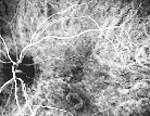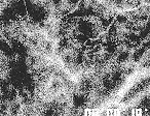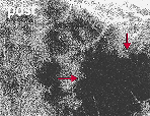Digital imaging provides more accuracy
New views of retinal pathologies improve surgical success rates.
Click Here to Manage Email Alerts
 View of CNV feeder vessel obtained from high-speed ICG angiography. Figure courtesy Bert Glaser, MD. |
Retinal surgeons applying digital imaging of the posterior segment find their diagnosis more useful and their surgical techniques more efficacious as a result.
Ophthalmoscopes create fine resolution images from lasers, fundus cameras combine images and computers manipulate the pictures into better diagnostic tools. Physicians can now store an image as part of the medical record, enabling them to compare two office visits and track disease progression.
Now, lasering on a choroidal neovascularization (CNV) or screening diabetics can stop pathology before it damages vision. Screening will eventually be come easier, faster and cheaper, enabling not only subspecialists, but also general ophthalmologists and optometrists to uncover disease earlier.
Expanding view
| ICG Angiography in an AMD Patient |
|---|
 Early angiogram of AMD patient before treatment shows feeder vessel (arrow) and lacy neovascular vessels. |
 Choroidal neovascularization involves the fovea. |
 ICG angiogram in the same phase as top right shows occlusion of the feeder vessel and disappearance of the neovascular vessels after feeder vessel photocoagulation, with the fovea spared. Arrows indicate treated area. Figures courtesy Fumio Shiraga, MD. |
Advances in laser technology have in creased the resolution of retinal images and even allow examination of retinal structures previously hidden from view.
Scanning laser ophthalmoscopy allows for easier screening over a larger area of the retina. A new unit in development by Optos applies red and green wavelengths to create an image of almost the entire retina that will be taken in two-tenths of a second.
According to Steve Guida, president of Optos/North America (Westborough, U.S.A.), the laser light enters the eye and each laser wavelength excites a different retinal layer. Mr. Guida said this creates more contrast and better images over other products that use only one wavelength.
The Panoramic 200 Nonmydriatic Ophthalmoscope allows physicians to scan the retina at an internal angle of more than 200° inside the eye in a nondilated pupil. This captures more than 80% of the retina - including the optic disc, macula, superior and inferior arcades, vortex veins and the far periphery.
Resolution is better than 20 µm on axis and 40 µm at the periphery. The 2,000 by 2,000 pixel image is up to 25 times the size of the normal 30° fundus camera.
The scan can be panned and zoomed, and it has a high depth of field so pathologies that protrude into the vitreous remain in focus.
Douglas Anderson, chief executive officer of Optos in Dunfermline, Scotland, said the instrument shortens not only exam times, but also the amount of light exposed on the retina.
The key advantages are the device's ability to capture a high resolution image of almost the entire retina without dilation or scleral depression, Mr. Guida said. Dilation consumes chair time and staff productivity, and forces the patient to wait and suffer from dilation for the rest of the day.
The company expected ISO certification and a CE mark in November.
Mr. Guida said the company is working with retinal specialists first, and then will move into the screening environment of general ophthalmology and optometry.
The company is conducting trials in the United Kingdom for more cost effectively managing diabetic retinopathy.
"A lot of diseases manifest in the periphery that aren't routinely seen in any other way," Mr. Guida said. "It will help physicians perform a more consistent screen that doesn't rely on fleeting glimpses and subjective interpretation."
Mr. Anderson added that some diseases manifest in the periphery earlier, so a wider scan field could bring patients into secondary care earlier, when pathologies are easier and cheaper to manage.
And like other digital technologies, the scan can be entered into the patient record, unlike fundus photos or drawings, which were cumbersome and not as easy to record.
Diabetics benefit
The Retinal Thickness Analyzer (RTA) combines a digital fundus camera and a computerized scanning slit lamp. It projects a 534 nm He-Ne laser onto the fundus and acquires optical cross sections of the retina in 0.2 seconds across a 2 mm by 2 mm area.
Ten cross sections are taken 200 µm apart and combined into a 20° field to provide two-dimensional and three-dimensional maps. The maps can be overlaid or the images may be viewed directly to detect macular holes, cysts and membranes.
According to Emanuel Binnun, chairman of RTA maker Talia Technology Ltd. in Israel, the RTA allows for fast measurements. The entire posterior pole can be scanned in a 3 to 5 minute examination.
The system's main uses are to detect diabetic macular edema, diabetic retinopathy and glaucoma. Like the digital ophthalmoscope, the image can be stored, and the RTA files can be used in spreadsheets and word processors.
The Talia system is used at 30 places around the world, including systems in American sites such as the Wilmer Institute in Baltimore, Manhattan Eye, Ear and Throat Hospital, New York Eye and Ear Infirmary and the Joslin Diabetes Center in Boston.
The Optical Coherence Tomographer (OCT) by Humphrey Systems (Dublin, U.S.A.), has uncovered new findings for diabetic retinopathy and macularedema.
Rosangela Lattanzio, MD, director of the Diabetic Retinopathy Service of the Department of Ophthalmology (chairman: Prof. Rosario Brancato) at the University of Milan, Italy, used OCT to uncover a link between macular thickness and the severity of diabetic retinopathy and macular edema. She concluded that the imaging technique is sensitive enough to detect early diabetic macular edema and to measure its reduction after laser treatment.
Dr. Lattanzio studied 108 diabetic patients who underwent a complete ocular exam, fundus biomicroscopy, fluorescein angiography and OCT.
Dr. Lattanzio said that macular thickness was higher in diabetics than normal subjects, even in patients without retinopathy, suggesting that subclinical retinal abnormalities occur before the onset of clinical lesions of the retina.
"The high-resolution cross sectional or tomographic retinal images of OCT can yield an in vivo alternative to histopathology and provide useful diagnostic information, complementary to conventional fundus photos and fluorescein angiography," she said. "OCT allows a reproducible and quantitative assessment of retinal thickness that in the past was only subjective."
ROP: easier, earlier, more accurate
Digital technology helps to document retinopathy of prematurity (ROP) with great ease and accuracy, according to Steven D. Schwartz, MD, of the Jules Stein Eye Institute in Los Angeles.
The RetCam 120 digital fundus camera (Massie Research Labs, San Mateo, U.S.A.) is a contact, panoramic device used to assess ROP and other pediatric retinal problems in the very young, low birth weight patients Dr. Schwartz sees.
The images are easier to obtain than the video indirect images, are more accurate and already digitized, making telemedicine applications easier, he said.
Babies undergoing screening do experience discomfort, and Dr. Schwartz reported at the Club Jules Gonin meeting in Edinburgh, Scotland, that he often sees transient retinal arterial pulsations during image acquisition. But there were no episodes of significant hemodynamic or respiratory distress, nor were there corneal abrasions.
Dr. Schwartz also conducted a small-scale study to test the telemedical applications. Of 20 eyes screened, they found on site examination and telemedical concordance in 18 - that is, remote consultation with the RetCam 120 was accurate in 18 eyes.
"Six of these patients had plus disease with 100% agreement, the same six are required treatment," he said. "And 14 of the 20 eyes, or 70%, had stage/zone concordance, meaning we could say exactly from the pictures what zone the disease was in and what stage it was at."
Of the surgical patients, five of seven, or 71%, had surgical management agreement between on site and telemedical management decisions, he said.
The RetCam 120 does require a skilled examiner, has complex proprietary software and a bulky camera.
Faster, cheaper UBM ultrasound
In August, Paradigm Medical Industries Inc. (Salt Lake City, U.S.A.) acquired the rights to manufacture the ultrasound diagnostic products formerly owned by Humphrey Systems, which found ultrasound technology outside its core market in optical systems.
Paradigm, which already used ultrasound in its phaco systems, wants to turn the research system into an affordable diagnostic tool, said Robert Millar, vice president of engineering and research for Paradigm.
Paradigm intends to combine The Ultrasound Biomicroscope (UBM) with its ocular Blood Flow Analyzer to create a Glaucoma Workstation.
"Glaucoma is such a growing problem," Mr. Millar said. "We intend to put the UBM into as many hands as possible."
Toward that end, the company re-established relationships with Charles J. Pavlin, MD, and Stuart Foster, PhD, who invented the original UBM, and with Robert Ritch, MD, who all worked on previous glaucoma systems.
Dr. Pavlin, of the University of Toronto, said the new machine will be similar to previous versions, but simpler software makes the unit easier to use.
Mr. Millar added that Paradigm now produces a system that provides a good signal and image that presents a magnified cross sectional image of the anterior chamber. Improvements are planned for the probe, as well as software upgrades that will add user-friendly graphic analyses. Physicians could be allowed to place the ultrasound image on screen, and apply tracings, calculate angle openings, find iris volumes and perform other important analyses.
UBM imaging typically runs at 50 MHz, and a range of 20 MHz to 60 MHz or higher can be applied to vary the attenuation of the signal in ocular tissue. At 60 MHz and higher, more finite corneal analysis can be conducted.
B-scan goes 3-D
Three-dimensional imaging is now being applied to ultrasonography of intraocular pathologies such as ocular tumors and choroidal detachments, said Yale L. Fisher, MD, in practice in New York.
Three-dimensional imaging is not new, but previous units required a water bath or lab-based computer technology. A new device from Ophthalmic Technologies Inc. in Canada uses a contact B-probe that captures images from a digital B-scan unit in a short period of time and reconstructs them into a 3-D tomographic image with the correct XYZ axis.
When a standard B-scan uncovers pathology that could benefit from 3-D imaging, the probe is placed into a motorized handpiece. The digital B-scan images are transmitted to a modified desktop computer, which captures and displays the eye in 3-D.
The probe rotates axially just over 180° in a period of 5 seconds, following which the 3-D image is immediately available for viewing. Most patients can hold their eyes still for 5 seconds, allowing the machine to capture consecutive multiple images, to reconstruct a 50° cone within the eye and the orbit. With the proper immersion technique, the entire globe may be captured within the 50° view cone.
Software allows for multiplane slicing, surface rendering, linear and volume measurements of tumors. Previous volume measurements have relied on theoretical formulas to determine tumor size, Dr. Fisher said.
Phantom studies demonstrate that the volume measurements are accurate and reproducible, he said. Linear measurements had less than 1.5% variation from the actual mass and 4% variation in volume.
Clinical studies evaluated 110 patients with conventional B-scans, and 16 patients with tumors were followed with 3-D B-scans. The studies confirmed the reproducibility.
"This thing is great for teaching," Dr. Fisher said. "For the first time, I can show a student with no experience in ultrasound imaging how several different pathologies appear on B-scan, from any angle whatsoever."
The 3-D B-scan can be used to plan surgery and to better understand ocular tomography. Also, it is easy to reconstruct slice images at orientation, which would be impossible to achieve with a conventional B-scan, such as a coronal view.
"It's the next step in ultrasonography," he said. "This will go into real time shortly." Rishard Weitz, the president of Ophthalmic Technologies Inc., adds that a high frequency 3-D feature is currently under development and will soon be added to the system.
Attacking CNV
High-speed angiography will detect feeder vessels previously hidden from view with standard indocyanine green (ICG) techniques, said Bert Glaser, MD, a Baltimore retinal specialist. The high-speed angiography will allow surgeons to treat previously unreachable feeder vessels.
Treating exudative age-related macular degeneration works with direct laser photocoagulation, but only a small majority of patients present with CNV not directly under the fovea.
A Japanese study found that extra foveal laser photocoagulation is the best method to treat the condition. Fumio Shiraga, MD, and others at Okayama University Medical School designed a pilot trial to assess lasering the feeder vessels without attacking the fovea directly.
Using a scanning laser ophthalmoscope, researchers examined 170 consecutive patients with new subfoveal CNV between 1993 and 1995.
Of that group, 37 met entry criteria and had symptoms of CNV. ICG videoangiography was performed with the Rodenstock Instruments (Danbury, U.S.A.) Scanning Laser Ophthalmoscope for high-resolution photos. The images were examined frame by frame to find the vascular connection from the choroid to the CNV.
One image was subtracted from the other pixel by pixel to detect changes. Researchers found and lasered feeder vessels in each patient.
Vision improved or stabilized in 25 of 37 patients, and 12 worsened. Researchers concluded that the scanning laser ophthalmoscope makes more distinct the image of the filling of the choroidal arterioles to the neovascular nets.
Dr. Glaser said, "The problem they encountered is that even with the subtraction technology and angiography, they were able to detect feeder vessels in only 22% of the patients. Clearly, the next step is the need to develop a better technique to detect these feeder vessels."
Because flow through the choroidal vasculature and other membranes is rapid and dynamic, static photography cannot capture it. The high-speed angiography takes images at four times the normal rate to find the feeder vessels.
Dr. Glaser conducted a small-scale pilot using high-speed angiography to direct his laser treatments in 40 patients.
He was able to detect the feeder vessels in more than half of that group - an improvement over the 22% identification rate in the Japanese study.
In some patients with previously undetectable feeder vessels, the new method showed them to be readily apparent. With proper laser treatment, their vision improved in as few as 2 weeks.
"Techniques such as fine motion or rapid sequential angiography will enhance hemodynamic data and allow us to develop a better understanding of the choroidal vasculature and its pathology," Dr. Glaser said. "Without this video component, we are losing tons of data. This is going to open a realm of understanding of what it is we're treating and how best to treat these patients."
For your information:
- Stephen A. Guida can be reached at 111 Turnpike Road, Ste. 102-2, Westborough, MA 01581 U.S.A.; (800) 854-3039; fax: ++(508) 870-9911; e-mail: sguida@msn.com. Mr. Guida is president of Optos/North America.
- Douglas Anderson can be reached at 16 Comely Park, Dunfermline fife KY12 7HV United Kingdom; ++(44) 1383-628-716; fax: ++(44) 1383-628-706; e-mail: danderson@optos.com. Mr. Anderson is chief executive officer of Optos plc.
- Charles J. Pavlin, MD, can be reached at the University of Toronto, Ste. 212, Donvale Medical Center, 597 Parliament St., Toronto, Ontario, M4X 1W3, Canada; phone and fax: ++(416) 923-3311; e-mail: cpavlin@home.com. Dr. Pavlin has no direct financial interest in any of the products mentioned in this article, nor is he a paid consultant for any companies mentioned.
- Robert Millar can be reached at 1127 W. 2320 S, Ste. A, Salt Lake City, UT 84119 U.S.A.; ++(801) 977-8970; fax: ++(801) 977-8973; Paradigmmed@Hotmail.com. Mr. Millar is vice president of engineering and research at Paradigm Medical.
- Emanuel Binnun can be reached at 106 Industrial Zone, PO Box 3780, Mevaseret Zion 90805, Israel; ++(2) 534-4023; fax: ++(2) 534-4486; e-mail: talia@talia.co.il. Mr. Binnun is chairman of Talia Technology Ltd.
- Yale L. Fisher, MD, practices at Riverterrace Medical Building, 519 E. 72nd St., New York, NY 10021 U.S.A.; ++(212) 861-9797; fax: ++(212) 628-0698. Dr. Fisher has no direct financial interest in any of the products mentioned in this article, nor is he a paid consultant for any companies mentioned.
- Rosangela Lattanzio, MD, director of the Diabetic Retinopathy Service at the University of Milan, can be reached at the Department of Ophthalmology and Visual Science, Via Olgettina 60, Milan 20132 Italy; ++(2) 2643-2648; fax: ++(2) 2641-2912; e-mail: brancato.rosario@hsr.it. Dr. Lattanzio has no direct financial interest in any of the products mentioned in this article, nor is she a paid consultant for any companies mentioned.
- Fumio Shiraga, MD, is director of the vitreoretinal service at Okayama University Medical School. He can be reached at the Department of Ophthalmology, Okayama University Medical School, 2-5-1 Shikata-cho, Okayama 700-8558 Japan; ++(86) 235-7297; fax: ++(86) 222-5059; e-mail: fumio327@msn.com. Dr. Shiraga has no direct financial interest in any of the products mentioned in this article, nor is he a paid consultant for any companies mentioned.
- Bert Glaser, MD, practices at Glaser Murphy Retina Center, 901 Dulaney Valley Road, Towson, MD 21204 U.S.A.; ++(410) 337-4500; fax: ++(410) 339-7326. Dr. Glaser did not contribute in the preparation of this article.
- Steven D. Schwartz, MD, practices at the Jules Stein Eye Institute, 100 Stein Plaza, Los Angeles, CA 90095 U.S.A.; ++(310) 206-7474; fax: ++(310) 825-0841; e-mail: schwartz@jsei.ucla.edu. Dr. Schwartz has no direct financial interest in any of the products mentioned in this article, nor is he a paid consultant for any companies mentioned.
